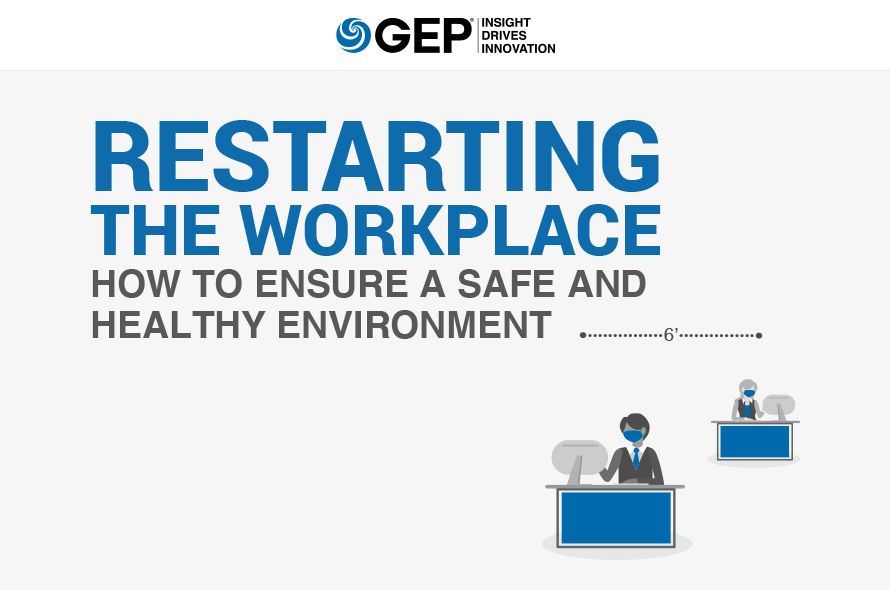Opening up offices again as COVID-19 infections remain a risk is no easy task. You can’t take any chances. It is essential to exercise caution and have a multipronged reopening plan.
In our latest bulletin, Restarting the Workplace: How to Ensure a Safe and Healthy Environment, GEP’s experts list ways to insulate offices from the COVID-19 risk as employees cautiously return to work. The bulletin outlines how to manage workforce reentry and implement new distancing and hygiene norms through collaboration and communication.
What’s Inside:
- How to reintroduce workforce in a staggered manner
- Ways to ensure constant spacing among employees
- How to implement new health and sanitation protocols
This is a must-read guide for business leaders and building owners on how to keep employees safe and help them feel secure as they return to work amid the risk of the coronavirus.
The COVID-19 pandemic has confounded politicians, scientists and business leaders alike. It’s an unprecedented event, and there’s no blueprint to follow to return to “normal.” As many countries, including the United States, leave the worst behind, leaders are starting to think about what the post-pandemic workplace should look like.
Health and safety are top of mind for business leaders and building owners as countries slowly start to reopen and relax “shelter-in-place” orders. Facilities management, procurement and HR teams will have to collaborate and execute a detailed reopening plan, keeping in mind the new requirements. Here are a few things that organizations should prioritize to ensure everyone’s safety and peace of mind:
Go Slow
The return to the workplace should be gradual and done over time — begin with no more than 25-30% office occupancy. Some regions have mandated that initially, occupancy must not exceed 50%. Consider starting by prioritizing essential employees, and work up from there.
Use the initial group as a pilot to test logistics and pathways within the office. Directional signage can be utilized to minimize traffic congestion. As the initial group establishes normalcy, gradually reintroduce the rest of the workforce as needed in 10-20% increments depending upon the size of the organization.
Keep in mind that everyone does not need to return to the office. Evaluate those positions that can be considered permanently as work from home (WFH).
Safety First
The building should meet state and local government standards before it reopens. So, appropriate Personal Protection Equipment (PPE) should be made available for tenants and visitors with the requirements stated clearly. Consider a thermal check kiosk at the entry to monitor the temperature of the people coming in.
Maintain Spacing
With social distancing being the new normal, employees will expect to be spaced properly from their peers. This is your opportunity to be creative. Consider spacing cubicles further apart, or if configurations cannot be changed, keeping every other cubicle unoccupied. Explore configuration alterations — you can seat employees in every other seat instead of a straight line. This will create more distancing opportunities. Also, consider alternating days in and out of the office to manage the number of employees on site at any given time.
Conference rooms can be converted into workspaces to enable social distancing. For less flexible spaces, such as elevators, consider limiting the number of riders to four at a time, one person per corner. Place floor markings for queuing as a reminder to maintain social distancing. There can also be directional indicators to better control the flow of traffic up and down elevators and stairwells.
Greater Sanitation
A clean work environment with well-defined cleaning protocols will put employees at ease. Cleanliness and hygiene requirements will change as a result of the pandemic. For example, you will need to install sanitization stations throughout the workplace for easy accessibility.
Expect to budget more for increased cleaning services based on revised post-COVID-19 standards. A spotless work environment with published procedures will be part of the new normal.
Care in Shared Spaces
Perhaps one of the biggest challenges will be maintaining spacing and cleanliness in shared spaces, and in high-touch areas (such as door handles, telephones, etc.). All soap and water dispensers should be touchless devices to minimize contact.
While media attention has focused on cafeteria services, not much consideration has been given to how to manage common spaces such as break rooms, conference rooms, parking lots and fitness centers. Until there is a detailed plan to manage the logistical flow of people in and through these areas, these places should remain closed. A scheduling system that limits employees into the break room and fitness centers may be one option. For conference rooms, limit the number of employees attending the meeting in person.
Communicate, Communicate, Communicate
Well-developed plans will be meaningless if leaders do not communicate to employees what has been done and what they should expect going forward. There’s no better way to dispel fear and doubt than by communication. Go that extra step — post signages with graphics to avoid language barriers; publish communications on changes and expectations; describe the detailed plan for reentry before anyone returns. Involve employees in finding solutions by offering an opportunity for employee feedback, and provide regular updates on how the process is going and the next steps to be determined.
Home as a Viable Office
The response to the pandemic has disproven the necessity for all employees to be on site. Employees do not have to be in the office to be productive. “U.S. workers increased their average workday by almost 40%, adding an extra three hours — the largest jump worldwide, according to NordVPN,” states a recent report in TechRepublic.1 Consider training for managers who are having trouble adapting to this new normal.
1 Esther Shein, “VPN and Desktop Use and Employee Hours Spike Due to the Coronavirus,” TechRepublic, 24 March 2020. Retrieved 22 May 2020 from https://www.techrepublic.com/article/vpn-and-desktop-use-and-employee-ho...
Expect Delays
There will be many projects that were in-flight and have been paused or delayed because of the pandemic. This is to be expected. Interactions can slow down when employees are not face to face. Get comfortable with the fact that delays will occur. Plan for contingencies accordingly to manage risks. Take the time to revisit all milestones and do a reset, taking into account the working style that has been impacted by the pandemic.
Plan for Future Risks
Many experts are predicting that there will be a resurgence of the coronavirus in the next flu season (fall-winter). Draw up a plan for emergency evacuations while maintaining social distancing. Work closely with the emergency preparedness team to establish protocols for response to a positive test case on the premises. These protocols should be in line with state and local mandates.
A New World, a New Working Order
We are in a new world. The way business is conducted may change forever. We must adapt to this change swiftly and effectively in order to minimize the impact of the pandemic. Change has always been inevitable in business, but no one anticipated this level of change. Those who adapt swiftly and innovate will emerge successfully on the other side of the pandemic and be more capable of handling unforeseen disruptions in the future.
RAPID RESPONSE SOLUTIONS FROM GEP
As the coronavirus crisis intensifies, managing your supply chain is going to get even more challenging. It may be worth finding a partner with deep experience in procurement and supply chain management to reinforce your capabilities and help you stay on course.
If you would like to have a conversation about how we can help, please reach out to our supply chain leadership.

Daryl Watkins
Senior Director, Consulting
With more than 24 years of industry and consulting experience, Daryl is an accomplished procurement and supply chain professional with subject matter expertise in facilities management transformation. He has a wide and diverse range of domestic and international experience across industries in areas of operations, strategic sourcing, mergers and acquisitions, SRM strategies and global negotiations of direct and indirect spend categories.

